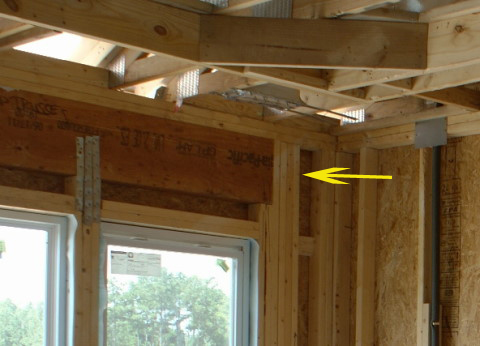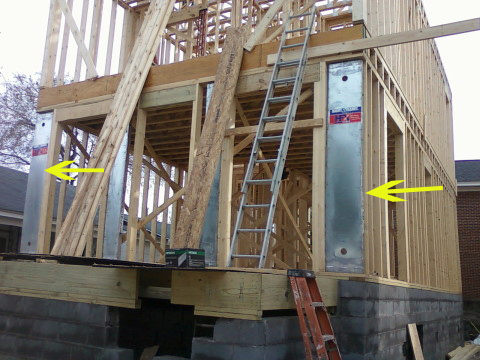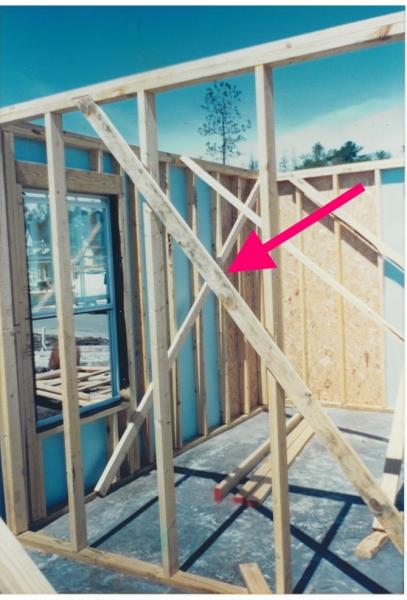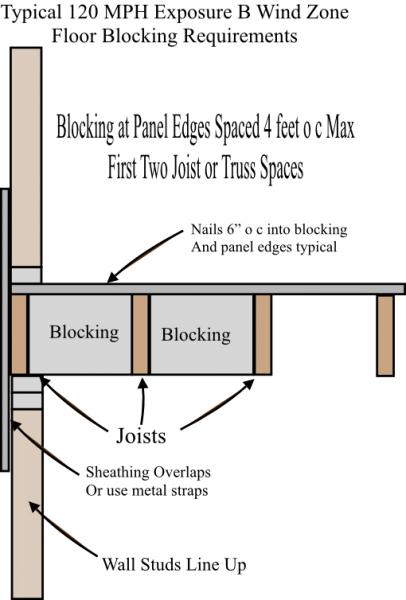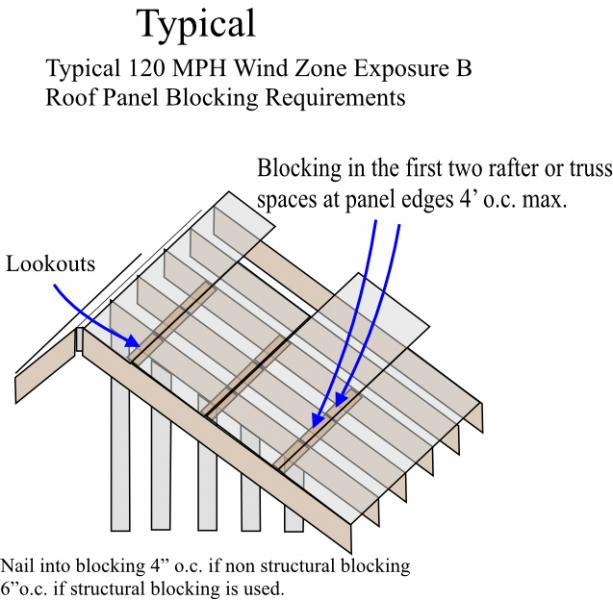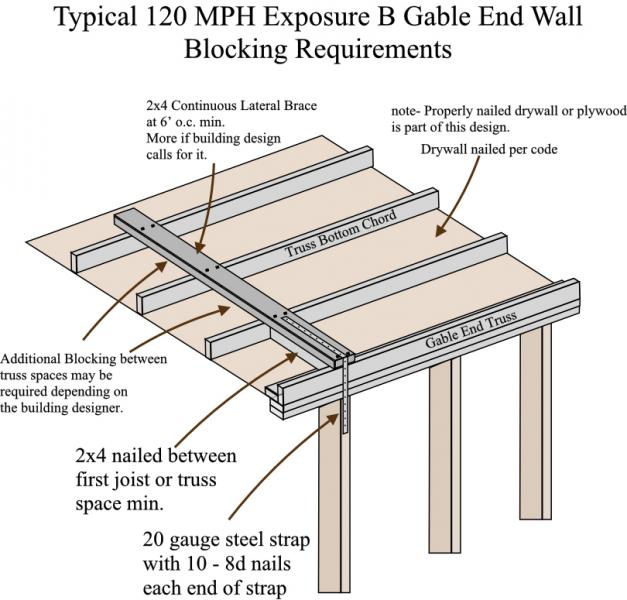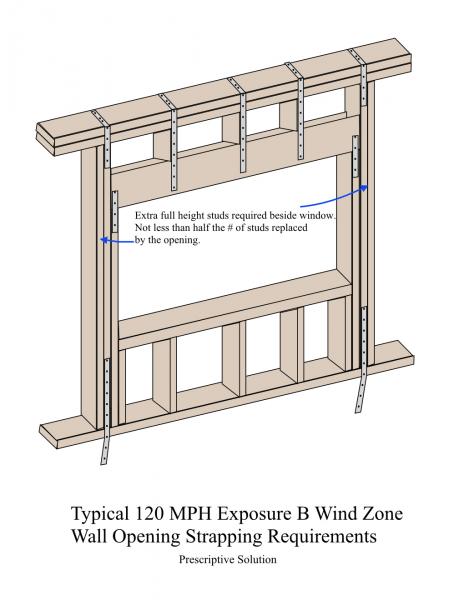- Home - Blue Palmetto Home Inspection of Summerville and Charleston
- Learn About Us and This Charleston Home Inspector
- What's Inspected
- Charleston Lowcountry Inspection Areas (geographic)
- Testimonials
- >>>Blogs (educational)
- Sample Reports & Documents
- Why Get a Home Inspection Report
- Charleston's Top Ten Reasons
- Home Inspector Photo Galleries
- Pricing
- Scheduling and Customer Information
- Home Inspection Authorization Contract
- General Scope of Work (electronic)
- Home Inspection Customer Satisfaction Survey
- Privacy Policy
- Full site
- The Roof Framers Field Manual
Charleston home inspector discusses wind zone requirements.
Submitted by Ray Thornburg on Fri, 10/19/2012 - 11:12
General Discussion
Charleston Areas Wind Zone Requirements Simplified
Wind zone requirements are a complex issue and this discussion is in no way intended to be a specific recommendation but just a general assessment of the kind of things you should expect to see on homes built in the Charleston area.
Most of the Charleston area is in the 120 mph wind zone and seismic design category D2. Some areas North of Meyers Rd. in Goose Creek is in the 110 mph wind zone. Berkeley county advertises to be in the 130 mph zone. See your building official for your exact requirements. South Carolina wind and seismic zone maps can be found here.
To understand what this means we must realize that the adapted 2006 code recommendations are usually good for wind speeds up to 100 mph.(Effective July 1, 2013 SC is using the 2012 code, go here for list of current codes adapted in SC and view the modifications to the code SC has adopted.) Some areas near the coast for instance have a higher anticipated wind speed and so additional measures must be taken to protect the property in a high wind event. IRC R301.2.1.1 references the WFCM (wood frame construction manual) as one required method. The American wood council has a free download of these manuals at http://awc.org/codes-standards/publications . The APA ( american plywood association) has technical information on how WSP (i.e. wood structural panels- plywood and osb sheets) can be used in high wind zones to reduce strapping requirements. You can find these at http://www.apawood.org/level_c.cfm?content=pub_searchresults&pK=wind&pT=Yes&pD=Yes&pF=Yes APA also has a wall bracing calculator which can be used to verify and comply with wall bracing requirements. It can be found here at APA wall Bracing Calculator.
Since the 120 and 110 mph wind zone requirements are similar our discussion will be more focused on that area. Again this is just a general discussion so that the average person can get an understanding of what’s required. The actual requirements for a particular structure are a combination of complicated calculations based on wind speed, building height, aspect ratio, engineering design, uplift, shear strength requirements, exposure category and prescriptive solutions (are your eyes glossing over yet) so we will focus our discussion on the prescriptive methods (which essentially means a set of rules the builder is allowed to follow because we know it works). OK! Enough of this talk…… these are the things to look for around here.
What to Look For
· First there must be a continuous load path of interconnected elements from roof to foundation. This is usually achieved by using metal straps, rafter ties, or using the sheathing when properly nailed.
· Studs must line up from floor to floor.
· Roofs, ceilings, floors shall be designed as diaphragms that receive the imposed lateral loads. Walls are designed to resist uplift and wind loads. (i.e. Floor and roof decks are diaphragms). These lateral loads are then transferred to braced wall lines or shear walls. (i.e. A braced wall line is prescriptive and a shear wall is designed by a professional.) All exterior walls are considered braced wall lines. In seismic design catigory D2 (most of our area) some interior walls have to be considered braced wall lines. Spacing of braced wall lines cannot exceed 25'. reference irc 2003 602.10.11
· Besides what framers normally do four 16d nails are required at the intersections of top plates and three 16d nails are required under each joist at the ledger to beam connection (no too close please or the wood will split).
· Fully sheathed walls with edge blocking at the panels overlapped at floor levels and nailed 6”oc edge/ 12” field. Where the WSP is used to replace a strap tighter nailing is required sometimes as close as 3" oc. Bottom line here is that they want a lot of nails. Some counties have a sheathing inspection just to make sure. The actually spacing for each area is sometimes derived at by calculations which is why you must know about a buildings aspect ratio.
About Building Aspect Ratio
Sometimes trying to figure out the requirements for nailing patterns, sheathing and hold down requirements can be a bit of a mystery. This is because prescriptive requirements for this change according to the shape of the building and other factors. To help solve this mystery one must know the buildings aspect ratio. The aspect ratio is determined by dividing the buildings length by its width. This will give you a number usually between 1 and 2.65 with 1 being a square building and 2.65 a narrow long building. After the aspect ratio is derived then the percentage of sheathing required on a wall, its nailing pattern, and hold down requirements can be derived by looking them up in a table printed in the wfcm. One thing you’ll notice is there is a separate table for the length (long side) of the building and one for the width (narrow side). You’ll also notice that the narrow side of the building will require more full height sheathing and a tighter nailing pattern. If a tighter nailing pattern is chosen (3” edge, 6” field for instance) then the percentage of full height sheathing that’s required can be reduced. Sheathing with WSP (wood structural panels) can be counted toward the percentage that’s required when it is 27.5” wide on an 8’ wall, 31” for a 9’ wall, 34” for a 10’ wall. Why is this important? Suppose a wall had a lot of windows and doors and couldn’t meet the minimum sheathing requirements. In that case an engineered solution might be the answer. We’ll take a look at some examples of that later.
More of What to Look For
- Sheathing should extend from the bottom of the bottom plate to the top of the top plate. reference icc 600-2008 standard for high wind const. 307.15 d
- Framing anchors at windows and doors. reference icc standard for high winds const. 307.1.5 e
- Provide drip edge at eves and gables on shingle roofs. icc standard for high wind const. 504.2.5
- Wall sheathing nails not closer than 3" o.c. reference icc standard for high wind const. 307.1 #3
-
The IRC is ambivalent towards panel orientation. Horizontal or Vertical panel orientation is treated equally for prescriptive solutions.
· Roof sheathing 24”- oc 4”edge/4”field, 16”- oc 6”oc edge/6”field. Near gable ends 4/4.
· Blocking between the first two truss spaces at panel edges at gable ends 4’ oc at the roof and at the floor level.
· Blocking between the first truss space at bottom chord gable end trusses. A continuous lateral 2x4 brace goes on to of the block every 6’ oc. A metal strap that goes over the top and down the outside of the sheathing is nailed with 10-8d nails each side.
· Studs continuous between horizontal supports.
· An extra full length stud is nailed to the outside of jacks supporting the headers. The actual # required is “not less than ½ the # replaced by the opening” So it sounds like a 4’ header needs two additional full length studs (one each side).
· Blocking under load bearing walls.
· Rafters should be opposite each other if possible.
· Collar ties nailed with 5-10d nails each side or straps over the top.
· Straps at the jack bottom, top, and over the wall on each cripple stud over the header at each opening.
· Depending on the building aspect ratio and the # of stories - 5/8” foundation bolts can be spaced as close as 18”on center and must be held down with 3” square plate washers ¼” thick. However- there are other ways to do this one is the simpson masa mudsill anchor which can be stronger than the anchor bolts commonly found. Information on it can be found here.
· Rafter ties are usually shipped with the trusses and therefore are sized and by their engineers. In any case they must be capable of resisting uplift forces for that zone.
· There’s a certain type of heavy duty hold down device required at each end of a garage door openings and shear walls. See picture.
· Trusses should be braced per the manufactures recommendation. In lieu of those documents see the bsci 1-103 guide for guidance. It can be downloaded here - http://www.sbcindustry.com/docs/06_BCSI_booklet_FINAL.pdf .
· If the home has a floor system then two foundation straps can be used per pier to get the recommendation uplift resistance depending on the rating of the manufacturer.
· Additional bracing at gable ends ( gable web reinforcement) can be achieved by using a catwalk type brace braced either to the roof or ceiling diaphragm.
Simpson strong tie has a manual that helps to explain how their products can be used to satisfy wind load requirements up to 110 mph. It can be found here. Another simpson technical high wind manual can be found here.
Bottom chord truss bracing should not be neglected. The bottom chord truss braces are required during erection and can become permanent lateral braces which are required. They are installed at about 10' intervals and are in addition to the wind zone braces which are often added later. There is more information on bottom chord truss bracing at my Truss Bracing Requirement Page.
These are some of the things to expect in the 120 mph exposure b wind zone. Bear in mind that interpretations and enforcement vary among inspectors and jurisdictions. Now lets look at some pretty pictures.
Field Examples
Example of 3x3 plate washer. on left is one that was added after construction so as to satisfy the requirement of a bolt at the end of a plate section.
In this picture you can see the blocking at the first two rafter spaces, the blocking at the truss bottom chord and the two x four on top of the blocking. In addition you can see the catwalk on the gable being braced back to the ceiling diaphragm.
Here is a closeup view of the strap at the gable end. See how it exits and is bent down over the outside.
Here is an example of how full studs are added beside the jacks. There should be straps on that side of window also.
Example of how even the inside walls are sheathed for the wind zone requirement. Inside garage wall seen here is typical.
Example of post anchor at bottom. Typical of required hold down.
Example of post anchor at top.
In the corner you can see an example of hold down device used to stabilize garage wall. Also visible are the 3x3 plate washers.
Picture of a hold down strap at a garage door opening. This is another way of meeting the requirement. When these are used the header is usually ran across the entire wall as seen below.
Running the header through to the corner increases the strength of the wall section. Lots of nails are used.
Here is another picture of the blocking at the gable with a 2x4 on top of it (good work). Absent is the proper bottom chord truss bracing which should go all the way to the opposite wall on at least 10' intervals.
A mudsill anchor like the one pictured can actually be stronger than a bolt and 3x3 washer. More information on this type of anchor can be found at this link.
Spacing of foundation straps like the ones shown in the picture on this Charleston home are determined by the architect or engineer who drew the plans. The small holes are for approved nails or a bolt can be used through the bigger hole.
Hardy Frames like the ones shown at left was the choice of this engineer. They are used in high wind areas where the required percentage of sheathing due to window and door openings cannot be achieved.
Hardy Frames like the one in this Charleston home are typically attached using massive bolts. The smaller holes are for screws. The Hardy Frame website has installation manuals available for download.
Here you see how the edges of sheathing are blocked solidly. It does not matter if the sheathing is hung horizontally or vertically as long as the edges are blocked.
Although the 1x4 let in corner brace as seen at left is only good for wind zones below 100 mph and seismic categories A and B ( to meet the braced wall requirement) it is still quite useful technique to brace walls in certain other situations. At left it is being used to brace an interior non load bearing wall. This will keep the wall plumb until sheetrock or other wall finishes are applied. This technique is also a good way to brace smaller interior walls as needed.
Picture shows how the floor is blocked in the first two joist spaces.
Picture at left shows typical roof panel blocking requirements. Rafters are blocked in the first two rafter spaces.
Here is another pic to help you understand the prescriptive gable end wall blocking requirements. Remember these are only typical recommendations for buildings up to a certain size. The building designer may have additional requirements so always check the plans. Note* These braces pictured at left is in addition to the continuous bottom chord truss bracing which is typically installed every ten foot or so. See our Truss Bracing page for more info.
Picture at left shows typical strapping requirements for windows. Some people forget the cripples above the header are strapped too. The strapping at the window opening is required even if the wall is solidly sheathed.
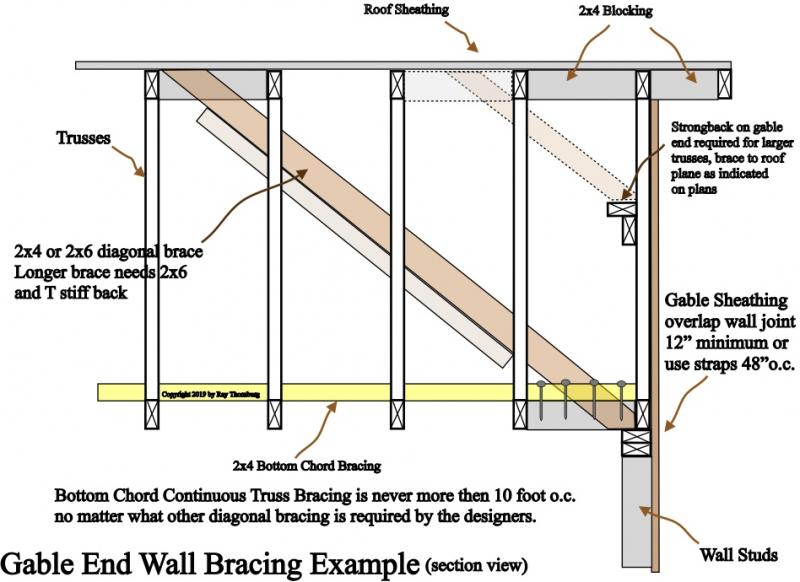 At left is an example of what one might be required to do to brace a roof gable end. If the architech wants it done this way it will typically be on the plans and might vary depending on the wind zone classification. Notice that the wall is braced to the roof plane instead of diagonally to another braced wall. This bracing if present still doesn't eliminate the need for bottom chord truss bracing. These bracing requirements will be on the truss design drawings. Truss manufacturers require at a minimum a continuous bottom chord truss brace every 10 feet no matter where the home is located geographically.
At left is an example of what one might be required to do to brace a roof gable end. If the architech wants it done this way it will typically be on the plans and might vary depending on the wind zone classification. Notice that the wall is braced to the roof plane instead of diagonally to another braced wall. This bracing if present still doesn't eliminate the need for bottom chord truss bracing. These bracing requirements will be on the truss design drawings. Truss manufacturers require at a minimum a continuous bottom chord truss brace every 10 feet no matter where the home is located geographically.
This article has mainly dealt with framing requirements but there is also other requirements for homes built in some high wind areas. (mainly along the coast) Some of these have to do with the type of windows and roofing materials and how they are nailed for example. Windows for example must meet certain wind ratings and have shutters. If shutters are not used then precut 7/16" osb panels can be used. These precut pieces can be installed in case of a wind event. reference 2012 IRC 301.2.1.2 exception

